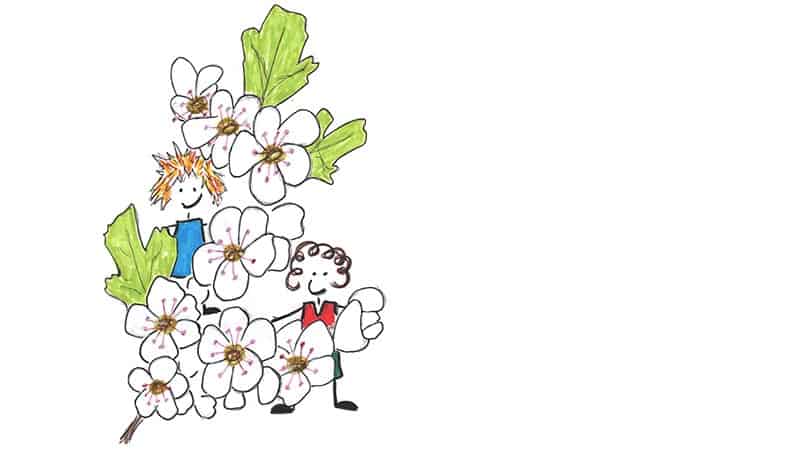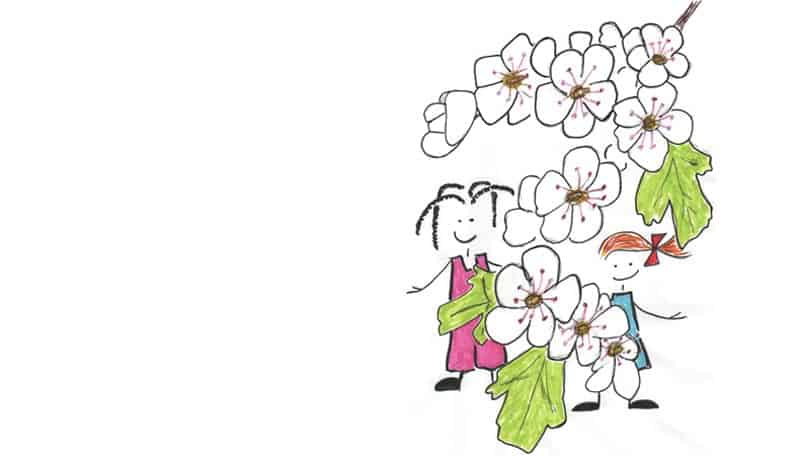I am writing this on the last day of April conscious that tomorrow is May Day which, traditionally, represents the peak of Spring and the beginning of Summer with an integral part of the celebrations being garlands made of hawthorn blossom, referred to as May Blossom, symbolising new spring life.
I used to question the relevance of this date as quite often the buds haven’t yet blossomed. Any May Day celebrations I was ever involved with have, at best, required me to don several layers or, at worst, add my cagoule and galoshes to give me half a chance of remaining warm and dry enough to stay outside for the duration. Digging a little deeper into the Myth and Folklore I found that the may flower always used to blossom on May Day but there was a calendar change in 1752 which meant it would more often be the middle of May before these flowers burst out from the protection of the bud. Here in Suffolk though, after that change, if a servant was able to find a sprig of blossoming may flower and bring it to the house on the 1st, they would be awarded a dish of cream as this was the only day when it was safe to bring hawthorn into the home.

I have heard several reports this morning that April 2021 has been the coldest on record since the early 1980s, but of course, we only have to cast our eyes to the hedgerows and look at the hawthorn’s closed buds to know it’s still pretty damn chilly out there.
Hawthorn is the tree of springtime and with an abundance of fresh green leaves sprouting from its thorny branches it’s a safe haven for the smaller birds to make their nests. The beautiful blossom of the hawthorn is the last to bud in our hedgerows. Last year was a record April again, though for the opposite reason, and as a consequence by now there were masses of delicate white, pink and deep red blooms consisting of five petals surrounding stamens with bright pink heads lighting up the hedges. This year, because of the sharp morning frosts, the petals are reluctant to spring from the protective casing of the bud so only if you look closely will you get a glimpse of the spectacle to come.
‘Ne’er cast a clout til may be out’ was a favourite saying of my grandparents who would never remove their vests until the may bush was in full flower. (actually, my grandad always wore a vest. He merely swapped his long woollen vest, which he tucked unceremoniously deep into his pants, for a lighter cotton version). So consequently, I was encouraged by them to wear my winter coat and keep my hat and scarf handy until this magnificent spectacle was well and truly upon us.
As you will have gathered ‘clout’ refers to warm winter clothing and ‘may’, in this instance, is the may blossom of the hawthorn rather than the month itself. So, you see, relying on nature to inform us, as this old saying illustrates, is a safer bet than checking the calendar. Many a time I have been frozen to my marrow in flimsy summer clothing because the calendar implies its summer. The hawthorn is connected to the web of intelligence that understands the variability of the British weather during spring and will know exactly when the sun’s powerful rays are resonating at their optimum to support the full cycle of bud to bloom and continue to nourish as the head of each stamen produces a fruit, called the haw, that will appear around July and ripen in October. These fruits resemble tiny, bright red apples and will feed our wild birds and be used to make hawthorn wine, jelly and medicinal tinctures.
The hawthorn is deeply rooted in folklore and is strongly associated with Beltane as, traditionally, this ancient fire festival that celebrates the coming of summer only began when the may had blossomed. So, May Day was celebrated when nature dictated, not on a fixed date of the calendar. Perhaps that is why all illustrations of ancient festivals depict a glorious sunny day rather than the rain soaked spoils of modern events. Beltane celebrates the many gifts of nature from the new born animals to the blossoming of our plant life. Hawthorn in particular represents love and protection and is a symbol of this time of year when the earth energies are at their strongest and most active.

Folklore also tells us that women would collect the dew from the leaves during May as washing their faces in it would preserve their beauty and the men thought that washing their hands in the dew would make them better craftsmen. Folklore, myth and superstition abound, its name comes from the Anglo-Saxon word ‘Hagedorn’ which means hedge thorn although, somewhere in there, Hag and Witch seems to have a relevance. Farmers used hawthorn in their hedges to protect their crops and cattle from witches and many a tale refers to the hawthorn as the horny bush of the hedgerow being the gateway to ‘the Other world.’
It is said that every hawthorn tree has a story, is one of the most sacred of all our native trees and has always been known as the fairy tree. Fairies live under the hawthorn to look after and protect it. These fairies are not the cutesy, harmless, magical little creatures that dance among the toadstools at the bottom of our gardens, Oh no … they are feared and respected as stories of curses and kidnaps are rife. Because of these stories the hawthorn is always treated with the greatest care and respect. As these trees stand on the threshold of this and the Otherworld they are under the protection of the fairies. You need their permission to remove them or you will feel their wrath and the whole village will suffer. The curse will affect new life and crops will fail, animals will not have young, chickens will stop laying and no children will be born so this tree is treated with great respect and care.
As I live in Hawthorn Cottage and the village green is locally referred to as Thorney Green, I am acutely aware of the importance and splendour of this magical tree. Crataegus monogyna (hawthorn) is a tree of magical enchantment. It informs us when to plant, it symbolises love, protection and new life. If revered and respected it can carry on giving for over 400 years and from a naturopathic perspective the berries are loaded with antioxidants, may have properties that are anti-inflammatory, aids blood pressure, aids digestion, help prevent hair loss (circulation), reduces anxiety and protects the heart.
Next time you are walking by a hedgerow look out for the hawthorn and if you happen to come across a lone tree in the countryside spare a few minutes to sit and ponder. It is there you are most likely to find yourself in the company of one or more of the fairies. If you would prefer to keep this as a story rather than a reality then don’t dally on May Day or Halloween as this is when you are most likely to encounter these little folk stepping through the gateway from the Otherworld and just maybe … they might take you back with them.




